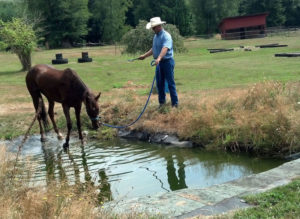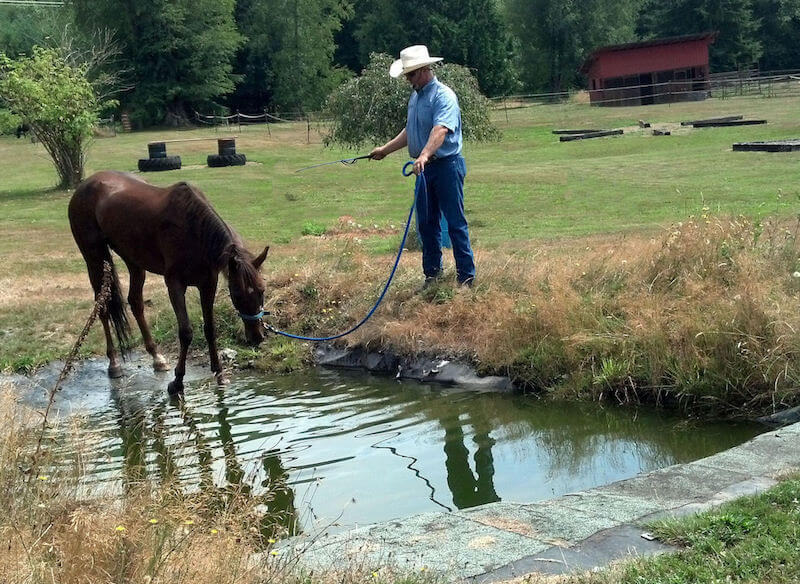by Marilyn Pineda
I love teaching trailer loading here at Fire Mountain Trail Course! There are so many types of communication and elements of confidence that come into play when a horse is comfortable with trailers. In my Riding Well Grounded article about impeccable timing I discuss loading a horse in a “must-do situation.” While that method will get your horse loaded in a pinch, the ideal situation is for your horse to self-load upon request.

The tools needed to accomplish trailering include the ability to send the horse forward, asking it to stand, and for it to have the confidence and trust to enter into an enclosed environment. As with any trail training, note the word “send” rather than “lead.” Unloading is just as important and tools needed in that task include the ability to ask the horse to back up as well as stand. All trail training needs to be at the end of a loose lead line. I recommend the use of a rope halter, a 12’ lead rope and a training stick for use as an aid to extend the reach of your arm.
A trailer is an especially scary sort of challenge for your horse because enclosed situations are perceived as a trap with no escape. It is best to practice sending your horse over or through other trail challenges that require confidence, such as a tarp or a pool of water, before trying a trailer for the first time. See above photo
As you do, understand that leading a horse requires no courage on his part, whatsoever. Courage requires making a choice to do something, even if it is a scary. If the horse is being led by the chin over a tarp, there really isn’t much choice involved. Also, if he sees that you can go across a trail challenge without being eaten alive, then there is nothing for him to fear and consequently courage isn’t required to follow you.
Once you are able to send your horse over or through other less frightening trail challenges and he has developed some confidence, you can begin working with the trailer. Stand at the rear left corner of the trailer and use sending signals to ask him to enter. If he hesitates at the edge of the trailer, do NOT turn him away to come again for another try. Keep him facing what he fears. You can offer an escape by backing him up until he is comfortable again. It doesn’t matter if he backs up crooked. Maintain your position by the trailer and, when ready, ask him again to load. Don’t rush it! He may go part way in and out for a while, but that is fine. Stay calm and persistent, using impeccable timing, and he will eventually choose to go in.
Once the horse enters the trailer his initial reaction may be to turn around and scramble out head first. Be prepared to use your training stick to point at his nose and keep him facing forward so the only choice he has left is to back out. It may be a clumsy scramble and that’s just fine; in the process of rushing backwards he will learn the right way to come out. Practice until he is brave enough to go in and stay. If he turns to look out, point at his nose with your stick to keep him facing forward.
After the horse has mustered up the courage to stand in the trailer a few moments, maintain your position at the back rear corner of the trailer and use the lead rope to ask him to back out. As he does, use the training stick to keep him facing forward. Pet him and allow some time to rest and relax before asking him to go in again.
The ability to safely load and unload your horse is a critical skill. It is just one of the Riding Well Grounded lessons that will benefit the relationship you have with your horse.
Published March 2014 Issue

The Northwest Horse Source is an independently owned and operated print and online magazine for horse owners and enthusiasts of all breeds and disciplines in the Pacific Northwest. Our contemporary editorial columns are predominantly written by experts in the region, covering the care, training, keeping and enjoyment of horses, with an eye to the specific concerns in our region.






